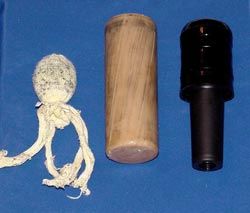 |
| “Sock/drag” round (lft.) compared to two large caliber rifled rounds |
Technology and the changes related to it are taking the police world by storm. Abstract concepts such as streaming mobile data, intelligence led policing, and GPS “best car” assignment strategies are all the “futuristic” rage. Likewise, when it comes to more grounded police concepts such as effectively engaging a mentally deranged, violent, and/or self destructive subject from a safe distance, one thing hasn’t changed; extended range impact devices rule. As a result, cutting edge systems such as the SAGE SL6 (with SSP-super soft point- rounds), Penn Arms 40mm, and PEPPERBALL are being effectively deployed with surprising frequency. In the face of greater energy and/or technical superiority, some are raising questions concerning the lowly 12 gauge “bean bag”. Is it still viable, or should this “flint chipping” device take its place in history along with its 1960’s counterpart, CN based “Chemical Mace”?
During the turbulent 1960s, America battled internally over the civil rights movement and our involvement in the Vietnam War. Thousands took to the streets in protest, and the police responded with batons, dogs, and water canons. In short order our major cities were in flames, and the unprecedented urban violence caused Lyndon Johnson to create a blue ribbon commission to study crime, law enforcement, and the administration of justice in America. One of the committee’s most significant recommendations was for the development of non-lethal weapons, which lead to a variety of “less lethal” technology concepts including the TASER™, CN based Chemical Mace™, and extended range impact projectiles such as the “bean bag”.
The original 12 gauge version was a 2 x 2 inch sewn cloth square bag filled with 40 grams of #9 lead shot. It was fired from a pump action shotgun or 12 gauge “billy club”, and had a muzzle velocity of approximately 400 feet per second. The round was thought to be “non-lethal”, was generally well received in the post civil rights era, and was on the road to wide spread acceptance when a 14-year-old New Mexico boy was killed with a shot to the chest in 1971. This singular fatal outcome with a so-called “non-lethal” round had collective accountability. Police agencies pulled the “bean bags” from the shelves, and it took almost 18 years for our operational needs and fading institutional memory to allow a general re-deployment of extended range impact capability.
 |
| Suspect after being shot in the hand with a “sock” type round to dislodge a pistol |
Since that time there has been a strong resurgence in the deployment of extended range impact projectiles, and none has been better represented than the 12 gauge “bean bag”. The “new” round was originally the mirror image of its 1971 counterpart, with the only change being a velocity reduction from 400 to 300 feet per second. The 120 foot/pound projectile proved generally safe and effective, but concerns over accuracy and angle of presentation caused manufacturers to shift from the square bag to one shaped like a baby sock. This resulted in dramatic improvements in performance, and the new design is used exclusively by contemporary agencies that choose to deploy 12 gauge “bean bags”.
The 12-gauge “bean bag” continues to be the most commonly used impact projectile in American policing, and for good reason.
- Everyone has shotguns, and this ensures that the multi round impact delivery system is cost effective, readily available, and easy to get into the hands of properly trained personnel. The vast majority of “less lethal” encounters are resolved by patrol officers in the first few minutes after arriving at the crisis site. Having an impact projectile system in almost every vehicle dramatically increases the probability that the technology will be available when needed-and that means lives will be saved.
- The new “sock” rounds are generally more accurate than the shooter who uses them, which suggests that in the hands of a skilled operator firing from a reasonable range, the potential for striking an unintended target such as the eye should be greatly reduced. The “sock” rounds have also generated an outstanding record of consistently conforming to the shape of the target on impact, which dramatically reduces energy density and minimizes the potential for causing a lacerating or penetrating injury.
- The device works. Those who advocate doing away with 12 gauge “bean bag” systems frequently lead in by stating, “the device doesn’t work”. The practical reality is the 12 gauge “bean bag” system has an excellent track record of success, when properly used by well trained personnel. The ready access, excellent accuracy, and rapid/multi-shot capability have disarmed countless subjects, and given field officers a viable option in some of law enforcements most challenging events.
All that said, is the 12 gauge “bean bag” the finest impact projectile system your agency can procure? Absolutely not. The large caliber (37-40mm) rifled launchers bring additional horsepower to the playing field (160 foot pounds of energy as compared to the 120), along with precision accuracy and triple the effective range. Unfortunately, they are also very expensive to purchase, train with, and operate. As such, most agencies reach a logical compromise between ready access and top performance. They put as many 12 gauge “bean bag” systems on the street as they possibly can, in order to ensure that field officers have an extended range impact option physically on the scene in almost every situation. They then procure a limited number of large caliber rifled systems, in hopes of having reasonable access to them in cases where extended range or special circumstances exist.
Extended range impact projectile systems provide a safe distance minimal force option, in cases where intervention is necessary but the suspect cannot be safely approached. The 12 gauge “bean bag” is one such system that has been proven safe and effective in numerous officer/suspect encounters, and should be seriously considered when evaluating the potential strengths and weaknesses of any impact projectile program.












